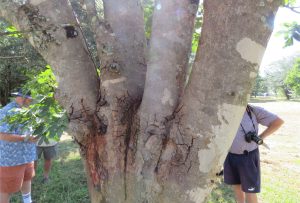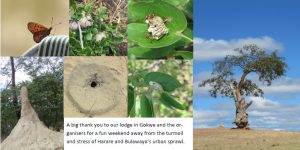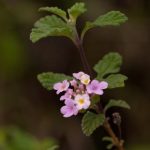TREE LIFE
MAY 2023

Welcome all, this is the bumper issue signalling the end of a year of Tree Society botanising and activities and the beginning of a new one going forward.
Further inside you will see a page dedicated to the A.G.M. and then social activities surrounding it. Once again we are being hosted by Rob and Sheila Jarvis, this time at their current home out at Pomona, on ART Farm. We look forward to seeing as many of you as possible for the occasion. Remember to bring a hat, an easy chair, your own drinks and glass if you need one, a plate of eats for the teas. And binoculars because their garden being a mix of woodland, food forest and open grassy meadow is ideal for bird watching.
You will get tea/coffee, lunch, and the chance to partake in some social activities. Hopefully the weather will hold and we expect to finish up around 3.00 p.m., allowing everyone the chance to get home well before dark, wending and weaving around the potholes.
Cheers, Tony Alegria, Chairman
OUTING TO LARMENIER: April 23, 2023
By Tony Alegria (Photos by Jim Dryburgh)
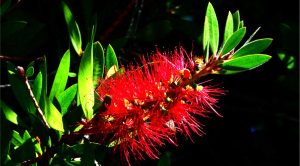
A few days before the tree walk, I delivered a Power Point presentation entitled “Introduction to Tree Identification” to some of the residents at Larmenier. I also had samples of the various leaf arrangements to show them. On the day of the tree walk I was pleasantly surprised to see the turn out by the residents. Along with the Tree Society members we had a group of over twenty people. It was good to see Ann Sinclair again – she has been unwell for quite a while, welcome back! Also present were two residents who had recently rejoined the society – Barbara and Peter Dean, who along with Pat Saunders numbered the trees with a magic marker and recorded what was what.
We began by looking at the trees around the club house where there was a mix of indigenous and exotic trees. Whilst so doing I was telling the residents what type of leaves the trees had as a way re-enforcing what they had learnt a few days before. So we had the bi-lobed leaf of the bauhinias, both white and the white/purple flowered ones. The twice pinnate leaves of the Koelreuteria bipinnata Chinese flame tree and also the Leopard tree, once pinnate of the Harpephyllum caffrum Wild plum, simple leaves of the fig trees, etc. There was one imparipinnate leaved tree we couldn’t identify and then there was the Tara spinosa – common name Tara. Although it looks very much like an Albizia with its twice pinnate leaves, the resemblance stops there. It has very pretty flowers, rather attractive smallish, thickish, purplish pods and has small hooked thorns on the leaves – not only on the rachis, but also between leaflets. There are three of these trees in the National Botanic Garden.
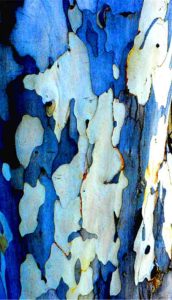
Leopard Tree bark (excuse the excessive blue).
After leaving the Club area, we went to see the trees within the complex along Ridgeway North road. But en route, we looked at Schotia brachypetala. Weeping boer-bean with its strange looking pale yellowish aril on the seeds, Jatropha integerrima, bottle brush trees and also a tree we had only seen in Dandaro, that is Metrosideros kermadecensis. New Zealand Christmas bush. And of course, there were others planted by the residents. Once we reached our destination, we had a large fig tree with biggish, long leaves we couldn’t identify. Also in this area, we saw a couple of baobab trees, Bocconia arborea, Celtis africana, a strange-looking munondo, Ficus burkei and a few others. Unexpectedly we also saw a Ficus benghalensis. Banyan with its red, sessile figs. This fig’s natural habitat is India and surrounds where it grows in high rainfall areas. There are two of them in the National Botanical Garden near the Herbarium.
By this point in time, it was about 11 o’clock and we ended the tree walk but were then asked to identify the odd tree by the residents.
So now we went to a specific cottage, path or road to see if could identify these trees. Mark identified: Heteropyxis dehniae. Lavender tree; Syzygium cumini. Java plum; Acacia farnesiana. Sweet acacia which is probably native to tropical America; Lonchocarpus sericeus. Lilac tree. There were also a couple of pink Tabebuias, now without flowers so they couldn’t be identified.
All in all a very satisfying morning of botanising.
BOTANIC GARDEN OUTING: 1 April, 2023
BY ROB JARVIS (Photos by Rob Jarvis unless otherwise stated)
Led by Tony Alegria, with expertise provided by Mark Hyde and Meg Coates-Palgrave a few of us assembled, somewhat nervously in case we were being taken for a ride as Fools on this auspicious day. Fortunately, the business was serious and no one fell for any traps. The aim was to look at various trees that we were likely to encounter on the expedition to be taken later in the month to the Mafungautsi Plateau around Gokwe in northwestern Zimbabwe.
So we saw baobabs, terminalia, Mugongo or manketti nuts, Schinziophyton rautanenii, false mopane (Gibourtia) and the Holy Grail itself, Baikiaea plurijuga, Zimbabwe teak, a few trees, but looking very different from each other.
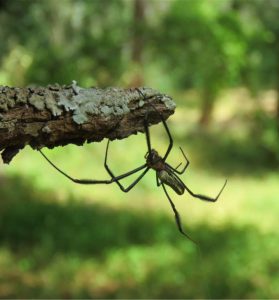
Golden orb spider
In practice for Mafungautsi we also kept our eyes peeled for wildlife and spotted this suspected Golden orb spider in the photograph right suspended on a branch of one of the trees.
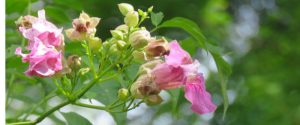
Zimbabwe creeper
Coming off the boil was a Zimbabwe creeper, Podranea brycei with just a few flowers left with some hint of its extravagant colour for such a hardy liana.
The group was perplexed by TBS trees, (Tall brown-stemmed) and looked warily on as the only member from Matabeleland took pictures only, of the tree, but claimed they came from his kumusha!
Guibourtia coleosperma, false mopane were growing surprisingly well in the Botanic Garden considering that they only occur in isolated patches in their natural habitat in lowland areas of the south and west of Zimbabwe. It is called rosewood, copalwood or machibi hereabouts and the wood has a distinct menthol scent when sawn.
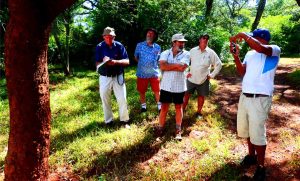 The leaves of false mopane are seen below (left) and a pure stand of these trees makes quite a sight in its habitat.
The leaves of false mopane are seen below (left) and a pure stand of these trees makes quite a sight in its habitat.
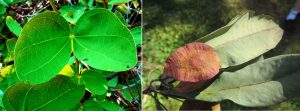 The mongongo nut were just starting to get their stunning fall colours with the leaves turning a bright yellow. Fruit and leaves of Terminalia sp. on the right.
The mongongo nut were just starting to get their stunning fall colours with the leaves turning a bright yellow. Fruit and leaves of Terminalia sp. on the right.
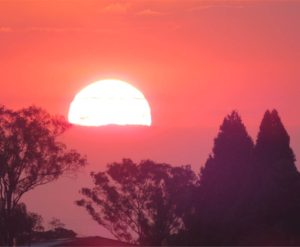 THE ANNUAL GENERAL MEETING OF
THE ANNUAL GENERAL MEETING OF
THE TREE SOCIETY OF ZIMBABWE
The 73rd A.G.M. will be held at the home of Rob and Sheila Jarvis at ART Farm on Sunday 21st May 2023 at 10.00 a.m.
Any proposals/resolutions and nominations for office bearers (and any volunteers to be on the Committee) should be forwarded by email to the Secretary, Teig Howson at: teig.howson@gmail.com by Thursday 18th May if possible, although proposals and nominations will be accepted from the floor. Venue details and directions to follow. N.B. The minutes of the 72nd A.G.M. held last year will be circulated again by email and thus will be taken as read at this years’ A.G.M. You need to be paid up to vote – you can pay your subscriptions in US$ at the A.G.M.
AGENDA:
- Notice convening the meeting.
- Apologies
- Matters Arising
- Chairman’s Report
- Treasurer’s Report
- Election of Office Bearers
- Any other business
However, as we have done in the past, we will be having the social on the same day, Programme below:
10.00 Coffee/Tea and Eats
10:30 A.G.M.
10:45 Scavenger Hunt
12:00 Socializing and lunch
13:00 Fun Quiz and Bingo
15:00 Coffee/Tea/Eats and socializing
Lunch will be provided and will consist of a Potjie and sides kindly organized by Rob and Sheila Jarvis. Details to follow. Bring your own chair and drinks and snacks for tea. Plates, mugs and cutlery provided. If you drink out of a glass, bring your own.
Big, Big Prizes in the Quiz and Scavenger Hunt!!!!
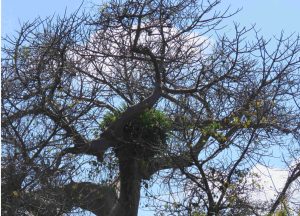 TREE SOCIETY VISIT TO THE MAPFUNGAUTSI PLATEAU
TREE SOCIETY VISIT TO THE MAPFUNGAUTSI PLATEAU
AN OVERVIEW
TEXT AND PHOTOS BY ROB JARVIS
It was with some anticipation that our Society set off for Gokwe and the Mapfungautsi Plateau, over the weekend of 15th to 18th April. The expedition was well organised by Frances Lovemore and Peter Morris and we were taken to a beautiful forest managed by the Forestry Commission not too far away from the urban centre of Gokwe. In my own case I had been visiting this area regularly from the late 1970’s until about 2007 and had seen the area grow from a beautiful, sparsely populated well-wooded plateau and lowveld-like vegetation down the escarpment towards the Sengwa and Sanyati river basins, into a centre for cotton production and sawmilling with ginneries, supermarkets, lodges and all manner of economic activity seen everywhere. We caught just a glimpse of the Lowveld, as we went searching for a mountain on the way to Chireya that is reputed to have a deep ravine cut through the red sandstone cliffs by endless herds of elephants seeking grazing and respite on the cool plateau top. Unfortunately, the road deteriorated so badly once the tar ended we abandoned that trip. However, we did go into the magnificent miombo woodland forest surrounding the Forestry Commission’s local headquarters and saw some absolutely spectacular Msasa trees that towered above everything else in sight.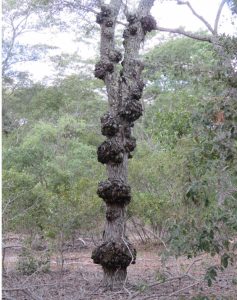
The tree on the right we called the Abacus tree and you can probably estimate its age by allocating a human generation of 25 years to each of the galls on the main stem. Saves murdering the tree to count the rings.
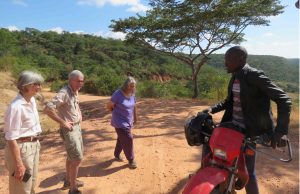
The locals of Gokwe are very welcoming and when a breakaway group of us decided to return back via the Njelele road, which wends down the escarpment to Empress Mine and thence to the banks of the Umniati River, we met this entrepreneur Alexander, who is a butcher operating in Gokwe town and he buys cattle far from town and then ships them up to slaughter where the market is. This particular spot where we stopped had breath-taking views down into the upper catchment of the Sanyati River. The trees were magnificent, virtually untouched by mankind with mountain acacia, Mufuti, Msasas and Munondo dominant. Bird life abounded just where we stopped.
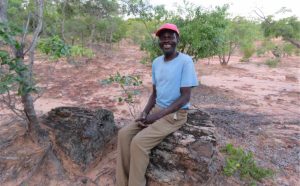 On one of our expedition days we tried to finish off the activities by seeking the Mapfungautsi Fossilised Forest. Unfortunately, it got rather late and most vehicles turned back and only ours containing Ryan, myself, Sheila, took the last corner and met an excellent guide called Peter who took us to the fossilised forest only a tantalising kilometre or two from where all the other cars had stopped. Anyway, the petrified logs were well worth seeing and most had a covering of lichens, giving them a greyish-green look. Somewhere along the way we had read on the internet and heard from locals that these rocks were green. However, it appears that the area with actual green rock tree logs do in fact occur, due to chromium compounds accrued in their fossilisation and these were to be found further down the Sengwa River basin just before it leaves the escarpment.
On one of our expedition days we tried to finish off the activities by seeking the Mapfungautsi Fossilised Forest. Unfortunately, it got rather late and most vehicles turned back and only ours containing Ryan, myself, Sheila, took the last corner and met an excellent guide called Peter who took us to the fossilised forest only a tantalising kilometre or two from where all the other cars had stopped. Anyway, the petrified logs were well worth seeing and most had a covering of lichens, giving them a greyish-green look. Somewhere along the way we had read on the internet and heard from locals that these rocks were green. However, it appears that the area with actual green rock tree logs do in fact occur, due to chromium compounds accrued in their fossilisation and these were to be found further down the Sengwa River basin just before it leaves the escarpment.
And so there is no doubt that we shall have to go back, with more time on our hands and a better idea of where we start the expedition so that we fully investigate the 400 million year-old trees that once lived hereabouts. Apparently they are similar to current pines and the probability is that the continent as it then was geologically positioned much closer to the South Pole and the climate was temperate. I know from my early days of going to Gokwe in the 1980’s that one of the roads I frequented passed through an area of petrified logs that were strewn about either side of the road. These logs looked very different to the ones we saw this past month. So we also have to find that place again.
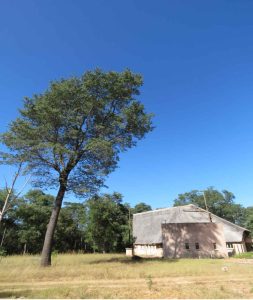 The Mapfungautsi Plateau and its surrounds are a fascinating area, whether it is the endlessly deep Kalahari sands that dominate it, with alternating wide open vleis flanked by rolling miombo woodland dominated ridges, or the lowveld approaches with patches of mopane woodland still dominating the sodic soil areas. And huge baobabs, pod mahoganies and Sterculia standing as trophy trees in every direction.
The Mapfungautsi Plateau and its surrounds are a fascinating area, whether it is the endlessly deep Kalahari sands that dominate it, with alternating wide open vleis flanked by rolling miombo woodland dominated ridges, or the lowveld approaches with patches of mopane woodland still dominating the sodic soil areas. And huge baobabs, pod mahoganies and Sterculia standing as trophy trees in every direction.
The cattle are fat and healthy, the people friendly and there is much to interest the explorer in all of us in venturing to the far corners of this amazing plateau. Around the Sengwa Dam we found a multitude of small critters living in or around the vegetation bordering the open waters. Reed frogs, paper wasps, grasshoppers, foam nests of mantids, dragonflies, butterflies of every description, bag worms, termitaria, were all there.
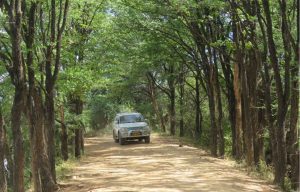 Bird life was a bit sparse but maybe an earlier start to each day would reveal more diversity in this department.
Bird life was a bit sparse but maybe an earlier start to each day would reveal more diversity in this department.
In Gokwe town I found that punctures could be fixed by squirting some pre-cooked sadza into the tubeless tyre. It is still plugged as I speak. We also found that no matter how heavily laden a combi, bus or truck is, it can still fit quite a few more passengers right on top of everything else lashed to the vehicle.
A big thank you to our lodge in Gokwe and the organisers for a fun weekend away from the turmoil and stress of Harare and Bulawayo’s urban sprawl.
TREE SOCIETY: MAPFUNGAUTSI TRIP FROM BULAWAYO
BY DI CHARSLEY
Cathy and I set off on our trip armed with plenty of hot water (for tea) to survive the journey which was a whole sight better than travelling to Hwange. When we got to Gokwe the Harare group had already arrived and although they spoke this foreign archaic language, we found them friendly and welcoming.
They were champing at the bit so we set off immediately to hunt trees at a nearby dam. There I was honoured to meet the legendary Meg. Torn between travelling in the light and enjoying the sunset, we got back to the lodge in time for supper and cheap beer in large bottles. It seems that the lodge’s clients usually drink straight from the bottle as the glasses were a bit smudgy. The staff seemed overwhelmed by the size of our group and we were not sure whether there was enough food to go round, but by the next day they had their mojo and there was plenty of food from there on. The rooms were interesting and presented their challenges, but nothing insurmountable—all part of an African adventure.
For the next two days, guided by forestry staff, we happily explored the Mapfungautsi Forest. As a beginner I was glad to have the help of new friends who showed me distinguishing features and increased my botanical vocabulary to include names like Kalahari Green-bubble. We went on roads less travelled which usually accommodate nothing wider than a donkey cart or had deep sand to test our drivers’ skills. We found ourselves at a sometime waterfall, vleis with bracken and Edenic forest cathedrals that pulled at the heart. A few even found the petrified forest.
Grateful thanks go to the Morrises, the Hydes and Tony for a memorable, well organised trip. Definitely on the do-again list.
Editor’s note: One of the first stops we made as a complete group was to botanise around a waterfall. Unfortunately, there was no water and so most of the party spent some considerable time looking for the waterfall. A practical “Where’s Wally” so to speak. We had hoped, given the very dry region that Bulawayans inhabit, that they would home in on the water of the waterfall, without difficulty. However, they proved equally inept at finding it. It is quite likely that everyone you can see in this photo, come January, is actually standing in the surging water of the waterfall as it speeds to the precipice. A good reason to go back to Gokwe, during the peak of the rains and tick off the waterfall.
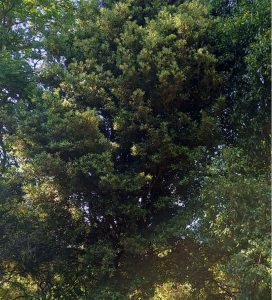 THE HOLM OAK
THE HOLM OAK
PHOTOS BY IAN RIDDELL
TEXT LARGELY FROM WIKIPEDIA
We (Mark and I) have been keeping tabs on the tree labelled as Sweet Pittosporum (Australian Cheesewood) Pittosporum undulatum, which grows near the small fish ponds at Mukuvisi Woodlands. Mark thought it might be Quercus ilex, from branches he took to the Herbarium, and at long last it has flowered and we hope acorns will follow. However, from looking online on iNaturalist, I would say the identification is correct, so have produced the following content, largely as it appears on Wikipedia linked to iNaturalist. One divergence from the ‘norm’ is that the flowers, few that there are, are not hanging in pendulous catkins. However, the tree is flowering quite weakly and if these were more developed they could droop.
Quercus ilex, the evergreen oak, holly oak or holm oak is a large evergreen oak native to the Mediterranean region. It is a member of the Ilex section of the genus, in the Beech family, Fagaceae, with acorns that mature in a single summer.
An evergreen tree of large size, attaining in favourable places a height of 21–28 metres, and developing in open situations a huge head of densely leafy branches as much across, the terminal portions of the branches usually pendulous in old trees. In the Mukuvisi Woodlands, the tree is confined by surrounding trees so has a more upright, non-spreading, form. The trunk is sometimes over 6 m in girth. The young shoots are clothed with a close grey felt. The leaves are very variable in shape, most frequently narrowly oval or ovate-lanceolate, 4–8 centimetres long, 1.2–2.5 cm wide, rounded or broadly tapered at the base, pointed, the margins sometimes entire, sometimes (especially on young trees) more or less remotely toothed. When quite young, both surfaces are clothed with whitish down, which soon falls away entirely from the upper surface leaving it a dark glossy green; on the lower surface it turns grey or tawny, and persists until the fall of the leaf; the petiole is 3–16 millimetres long. The new and old leaves, when present at the same time, contrast strongly. The fruits are produced one to three together on a short downy stalk, ripening the first season; the acorns usually 12–18 mm long in the UK, the cups with appressed, downy scales.
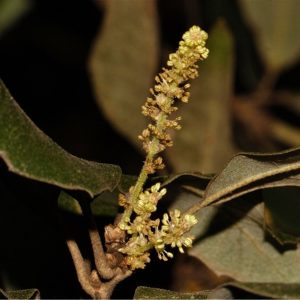 Taxonomy
Taxonomy
The resemblance of the foliage to that of the common European holly, Ilex aquifolium, has led to its common and botanic names. The name ilex was originally the classical Latin name for the holm oak, but was later adopted as a botanical genus name for the hollies. Quercus ilex is placed in section Ilex.
Quercus rotundifolia was previously thought to be part of this species but was later moved to its own. The common name ‘holm oak’ takes its name from holm, an ancient name for holly.
Distribution and habitat
Holm oak grows in pure stands or mixed forest in the Mediterranean and often at low or moderate elevations.
Quercus ilex is prevalent from Greece to certain parts of the Iberian Peninsula, where it mixes with Q. rotundifolia, along the northern Mediterranean coastal belt.
Ecology
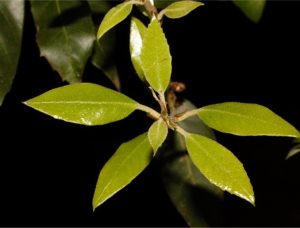 Holm oak is listed as an invasive species in the United Kingdom. Normally the tree is unable to withstand severe frost, which would prevent it from spreading north, but with climate change, it has successfully penetrated and established itself in areas north of its native range. The largest population of Holm oak in Northern Europe is present on and around St. Boniface Down on the Isle of Wight and into the neighbouring town of Ventnor, a town known for its naturally warmer microclimate, and has shown to tolerate the high winds on the downs. It is thought that this population’s propagation (which was established in the late 1800s after having been planted by Victorian residents) has been bolstered by native Eurasian jays (Garrulus glandarius), which harvest acorns from oak trees and store them by burying them in the ground where they may then germinate. Feral goats were brought to Ventnor to control the spread of the Holm oak.
Holm oak is listed as an invasive species in the United Kingdom. Normally the tree is unable to withstand severe frost, which would prevent it from spreading north, but with climate change, it has successfully penetrated and established itself in areas north of its native range. The largest population of Holm oak in Northern Europe is present on and around St. Boniface Down on the Isle of Wight and into the neighbouring town of Ventnor, a town known for its naturally warmer microclimate, and has shown to tolerate the high winds on the downs. It is thought that this population’s propagation (which was established in the late 1800s after having been planted by Victorian residents) has been bolstered by native Eurasian jays (Garrulus glandarius), which harvest acorns from oak trees and store them by burying them in the ground where they may then germinate. Feral goats were brought to Ventnor to control the spread of the Holm oak.
Cultivation and uses
The wood is hard and tough, and has been used since ancient times for general construction purposes as pillars, tools, wagons (as mentioned in Hesiod, Works and Days on page 429), vessels and wine casks. It is also used as firewood and in charcoal manufacture.
The holm oak is one of the top three trees used in the establishment of truffle orchards, or truffières. Truffles grow in an ectomycorrhizal association with the tree’s roots.
- ilex can be clipped to form a tall hedge, and it is suitable for coastal windbreaks, in any well-drained soil. It forms a picturesque rounded head, with pendulous low-hanging branches. Its size and solid evergreen character give it an imposing architectural presence that makes it valuable in many urban and garden settings. While holm oak can be grown in much of maritime north-western Europe, it is not tolerant of cold continental winters. It is a parent of Quercus × turneri, along with Quercus robur.
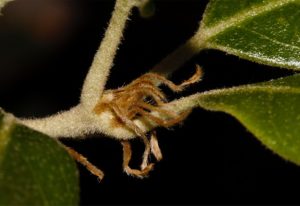 The first trees to be grown from acorns in England are still to be found within the stately grounds of Mamhead Park, Devon. From Britton & Brayley in The Beauties of England and Wales (1803): The woods and plantations of Mamhead are numerous and extensive. Many of them were introduced by Mr Thomas Balle (sic), the last of that family who, on returning from the continent brought with him a quantity of cork, ilex, wainscot, oak; Spanish chestnut, acacia, and other species of exotic trees.
The first trees to be grown from acorns in England are still to be found within the stately grounds of Mamhead Park, Devon. From Britton & Brayley in The Beauties of England and Wales (1803): The woods and plantations of Mamhead are numerous and extensive. Many of them were introduced by Mr Thomas Balle (sic), the last of that family who, on returning from the continent brought with him a quantity of cork, ilex, wainscot, oak; Spanish chestnut, acacia, and other species of exotic trees.
Notable trees
The Tree Register Champion in Gloucestershire measured 8.95 m in circumference and 12 m in height in 1993. Another tree at Courtown House, Wexford, Ireland, reputedly planted in 1648, measured 20 m in height, with a spread of 43 m in 2010. An ancient tree reputed to be 500 years old at Fulham Palace, London is listed as one of the Great Trees of London.
The oldest holm oak in Spain, the Encina Tres Patas de Mendaza, located in Navarre, is reputed to be 1,200 years old. A specimen in Milo, in Sicily, is reputed to be 700 years old, while a small population on the slopes of the northern village of Wardija in Malta are said to be between 500 and 1,000 years old. Prior to the Carthaginian period, holm oak was prevalent on the islands.
The Roman poet Horace predicted that the ilex growing on his farm would become famous when he included it in his hymn to the Spring of Bandusia there (Odes 3.13.12–16):
fies nobilium tu quoque fontium, (You will become one of the famous springs, too,
me dicente cavis impositam ilicem Now that I am telling of the ilex planted over your stone
saxis, unde loquaces Hollows, where your babbling
lymphae desiliunt tuae. Waters leap down.)
TREE SOCIETY COMMITTEE AND CONTACTS
Chairman Tony Alegria tonyalegria47@gmail.com 0772 438 697
Vice Chairman Rob Jarvis bo.hoom52@yahoo.com 0783 383 214
Honorary Treasurer Bill Clarke wrc@mweb.co.zw 0772 252 720
Committee member Jan van Bel jan_vanbel@yahoo.com 0772 440 287
Venue Organiser Ann Sinclair jimandannsincs@zol.co.zw 0772 433 125
Committee member Ryan Truscott ryan.kerr.truscott@gmail.com 0772 354 144
Secretary Teig Howson teig.howson@gmail.com 0772 256 364
Tree Society Website https://treesociety.org.zw/
Tree Society Facebook https://www.facebook.com/groups/ztreesociety/
Flora of Zimbabwe: https://www.zimbabweflora.co.zw/
Flora of Tropical Africa: https://plants.jstor.org/collection/FLOTA
And so we leave you with this tantalising view of one of the remaining few cathedral mopane to be seen along the gravel road that runs from Njelele through to Empress Mine. One day one hopes that Zimbabwe’s roads will be repaired and usable by all manner of vehicles instead of being only frequented by battle-hardened 4×4’s and Honda Fits. The vast hinterland of the country that we all now hardly know could then be accessible to everyone and tree adventures would truly beckon.


